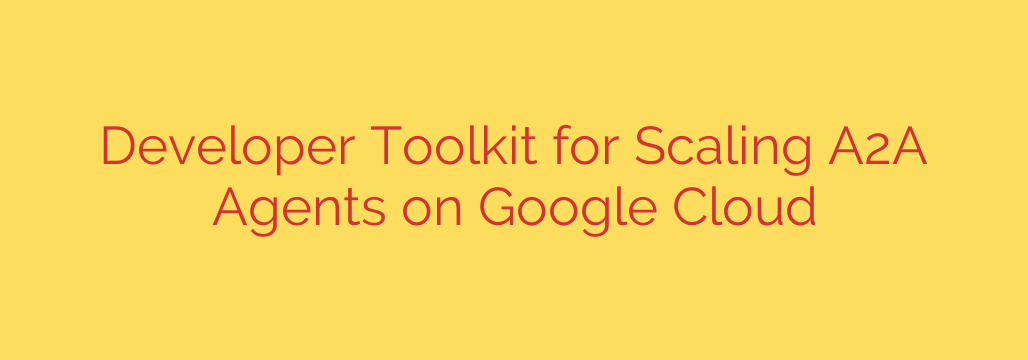
Scaling Your Conversational AI: A Blueprint for Secure A2A Agents on Google Cloud
Automated conversational agents are no longer a novelty; they are a core component of modern business operations. From customer service chatbots to internal workflow automation, these agents handle critical tasks. However, moving from a simple proof-of-concept to a secure, scalable, and reliable production system presents significant technical challenges. This is especially true for Application-to-Agent (A2A) agents, which interact directly with your backend systems and data.
Building these agents correctly from the start is essential for security and performance. Here, we outline a powerful reference architecture for developing and scaling A2A agents on Google Cloud, ensuring your automated systems are both intelligent and enterprise-ready.
What Are Application-to-Agent (A2A) Agents?
First, let’s clarify what we mean by A2A agents. Unlike simple Q&A bots that pull from a static knowledge base, A2A agents perform actions. They are integrated with your business applications to execute tasks on a user’s behalf.
Examples include:
- An agent that checks a customer’s order status by querying an inventory database.
- A voice assistant that books a meeting by interacting with a corporate calendar API.
- A chatbot that processes a refund by calling a function in a payment system.
These agents require a robust backend, known as fulfillment, which contains the business logic to connect the conversational interface with the application’s APIs.
The Core Challenges of Scaling Conversational Agents
As you scale A2A agents to handle more users and more complex tasks, you will inevitably face several hurdles:
- Security Vulnerabilities: A poorly secured fulfillment webhook is a direct gateway into your internal systems, making it a prime target for attacks.
- Performance Bottlenecks: An agent that is slow to respond creates a poor user experience and can fail under heavy traffic loads.
- High Operational Overhead: Managing servers, patching operating systems, and manually scaling infrastructure is costly and time-consuming.
- Lack of Observability: Without proper logging and monitoring, troubleshooting issues in a complex, multi-part system becomes nearly impossible.
A Production-Ready Toolkit on Google Cloud
To address these challenges, we can construct a powerful and secure architecture using managed Google Cloud services. This approach minimizes operational burden while maximizing security and scalability.
1. The Conversational Core: Dialogflow CX
The foundation of any great agent is its ability to understand and manage a conversation. Dialogflow CX is an advanced platform designed for building large-scale, complex conversational agents. It provides a visual state machine that makes it easy to design, manage, and debug intricate conversational flows, which is essential for enterprise-grade applications.
2. Serverless Fulfillment: Cloud Run or Cloud Functions
Instead of managing dedicated servers for your fulfillment logic, a serverless approach is far more efficient.
- Cloud Run allows you to run your fulfillment code in a container, giving you flexibility with runtimes and dependencies.
- Cloud Functions is ideal for event-driven, single-purpose functions.
Both services automatically scale from zero to handle any traffic volume and you only pay for the compute resources you use. This completely eliminates the need for server management and capacity planning.
3. The Secure Gateway: Apigee or API Gateway
Exposing your serverless fulfillment logic directly to the internet is a major security risk. The best practice is to place an API gateway in front of it. Google Cloud’s Apigee or API Gateway acts as a secure front door for all incoming requests.
Its key roles include:
- Authentication and Authorization: Ensuring that only Dialogflow (and other authorized services) can call your fulfillment webhook.
- Traffic Management: Protecting your backend from traffic spikes and abuse with rate limiting and quotas.
- Mediation: Transforming requests and responses if needed, providing a consistent interface for your agent.
4. Advanced Security Layers: Cloud Armor and IAM
To build a truly resilient system, you need multiple layers of defense.
- Google Cloud Armor provides a Web Application Firewall (WAF) and DDoS mitigation service. You can place it in front of your API Gateway to protect against common web attacks like SQL injection and cross-site scripting, as well as volumetric DDoS attacks.
- Identity and Access Management (IAM) is critical for internal security. By following the principle of least privilege, you ensure that your Cloud Run or Cloud Function service account has only the permissions it absolutely needs to interact with other Google Cloud services or backend APIs.
5. Essential Observability: Cloud Logging and Monitoring
You cannot manage what you cannot see. Google Cloud’s operations suite (formerly Stackdriver) provides the necessary tools for observability:
- Cloud Logging captures detailed logs from all services in the architecture, from Dialogflow to Cloud Run, providing a centralized place for analysis and troubleshooting.
- Cloud Monitoring allows you to create dashboards and alerts based on key performance metrics like latency, error rates, and resource utilization, enabling you to proactively identify and resolve issues.
Actionable Security Tips for Your A2A Agent
Based on this architecture, here are critical security tips to implement:
- Never Expose Fulfillment Directly: Always place your fulfillment logic behind an API gateway to control access and manage traffic.
- Enforce Strict IAM Policies: Grant service accounts the minimum permissions required. Avoid using broad roles like “Editor” or “Owner” in production.
- Use a WAF: Implement Google Cloud Armor to protect against common vulnerabilities and DDoS attacks at the edge.
- Validate All Inputs: Treat all data coming from the conversational agent as untrusted. Sanitize and validate every input in your fulfillment code before processing it.
- Secure Your Secrets: Use a service like Secret Manager to store API keys, database credentials, and other sensitive information instead of hardcoding them in your fulfillment logic.
By leveraging this robust toolkit, you can confidently build, deploy, and scale Application-to-Agent systems that are secure, reliable, and ready to meet the demands of your business.
Source: https://cloud.google.com/blog/products/ai-machine-learning/agent2agent-protocol-is-getting-an-upgrade/








